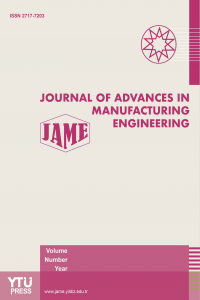EFFECT OF VISCOELASTICITY ON STIFFNESS PREDICTION FOR THE BI-ADHESIVE SINGLE LAP JOINTS
EFFECT OF VISCOELASTICITY ON STIFFNESS PREDICTION FOR THE BI-ADHESIVE SINGLE LAP JOINTS
Although the stress analysis of the adhesively bonded single lap joints(SLJ) has been studied in many papers there are limited investigations upon stiffness prediction of the adhesively bonded joints. There is also no study on the viscoelasticity effect on stiffness prediction of the SLJ in the open literature. In this study an analytical model was proposed for the stiffness prediction of the bi-adhesive SLJ with use of two types of adhesives SikaFast 5215 NT and SikaPower 4720 as flexible and stiff adhesives, respectively. Bond length ratio as a definition of the ratio of flexible adhesive length to stiff adhesive length was taken as d=0.2, 0.5,1 and 2. Bi-adhesive and mono adhesive results were compared. It was concluded that the joint stiffness can be strongly affected by the stiff adhesive proportion of the overlap length. Due to time dependent elasticity modulus as a result of viscoelastic properties of adhesives, joint stiffness reduces while time progresses. Results showed that adhesive stresses and joint stiffness can be optimized by using bi-adhesive joint with an appropriate bond length ratio. The adherend material effect was also studied. It was concluded that the adherend material is strongly affects the stiffness and stiffness reduction of the joint.
Keywords:
stiffness prediction, bi-adhesive Viscoelasticity, single lap joints,
___
- Reference1 Volkersen O. Die Niektraftverteilung in zugbeanspruchten Nietvervindungen mit konstanten Laschenquerschnitten Luftfahrtforschung. 1938; 15:41-47.
- Reference2 Goland M, Reissnerr E. The stresses in cemented joints. Journal of Applied Mechanics. 1944; vol. 11, p. A17-A27.
- Reference3 Raphael C. Variable-adhesive bonded joints. Journal of Applied Polymer Science: Applied Polymer Symposium, 1966; 3:99-108.
- Reference4 Carbas RJC, da Silva LFM, Madureira ML, Critchlow GW. Modelling of functionally graded adhesive joints. The Journal of Adhesion. 2014; 90:698–716. http://dx.doi.org/10.1080/00218464.2013.834255.
- Reference5 Özer H, Öz Ö. Three dimensional finite element analysis of bi-adhesively bonded double lap joint. International Journal of Adhesion&Science. 2012; 37: 50-55. https://doi.org/10.1016/j.ijadhadh.2012.01.016.
- Reference6 Kong FR, You M, Zheng XL. Three-dimensional finite element anlysis of the stress distribution in bi-adhesive bonded joints. The Journal of Adhesion. 2008; vol. 84, p. 105-124. https://doi.org/10.1080/00218460801952791.
- Reference7 da Silva LFM, Adams RD. Adhesive joints at high and low temperatures using similar and dissimilar adherends and dual adhesives. Internationl Journal of Adhesion&Adhesives. 2007; vol. 27, p. 216-226. https://doi.org/10.1016/j.ijadhadh.2006.04.002.
- Reference8 Delale E, Erdoğan F. Viscoelastic analysis of adhesively bonded joints. Journal of Applied Mechanics. 1981; vol. 48:331.
- Reference9 Shisesaz M, Reza A. The effect of viscoelasticity of polymeric adhesives on shear stress distribution in a single lap joints. The Journal of Adhesion. 2013; vol. 89, p. 859-880. https://doi.org/10.1080/00218464.2012.750581.
- Reference10 Shizesaz M, Reza A. The effect of viscoelasticity of adhesives on shear stress distribution in a double-lap joint using analytical method. Journal of Adhesion Science and Technology. 2013; vol. 27, p. 2233-2250. https://doi.org/10.1080/01694243.2013.769085.
- Reference11 Pearson IT. The parametric analysis of a bonded overlap joint resulting in design guideline and a representation for finite element analysis. Strain. 2001; vol. 37, No. 3, p. 113-122.
- Reference12 Kumar S, Pandey PC. Behaviour of bi adhesive joints. Journal of Adhesion Science and Technology. 2012; vol. 24:7, p. 1251-1281. https://doi.org/10.1163/016942409X12561252291982.
- Reference13 Zhao B. Stress and stiffness analysis of bi-adhesive bonded single-lap joints. Journal of Mechanical Strength. 2009; vol. 31(1), p. 095-103.
- Reference14 Owens JFP, Lee-Sullivan P. Stiffness behaviour due to fracture in adhesively bonded composite-to-aluminum joints I. Theoretical model. Internation Journal of Adhesion&Adhesives. 2000; vol. 20 p. 39-45. https://doi.org/10.1016/S0143-7496(99)00013-5.
- Reference15 Owens JFP, Lee-Sullivan P. Stiffness behaviour due to fracture in adhesively bonded composite-to-aluminum joints II. Experimental. Internation Journal of Adhesion&Adhesives. 2000; vol. 20 p. 47-58. https://doi.org/10.1016/S0143-7496(99)00014-7
- Reference16 Karlsson P. Determination of viscoelastic properties of adhesives. MSc Thesis, Linnaeus University, Sweden, 2014.
- Reference17 Monteiro JPR, Campilho RDSG, Marques EAS, da Silva LFM. Experimental estimation of the mechanical and fracture properties of a new epoxy adhesive. Applied Adhesion Science. 2015; p. 3:25. https://doi.org/10.1186/s40563-015-0056-y.
- Reference18 Karlsson F, Tartes K, Ramic Z. Increasing damping capacity of shear walls with glued –nail joints. MSc Thesis, Linnaeus University, Sweden, 2012.
- Reference19 Cardon AH. Durability analysis of structural composite systems. Lectures of the Special Chair AIB, 1996 Brussels, Belgium.
- ISSN: 2717-7203
- Başlangıç: 2020
- Yayıncı: Yıldız Teknik Üniversitesi
